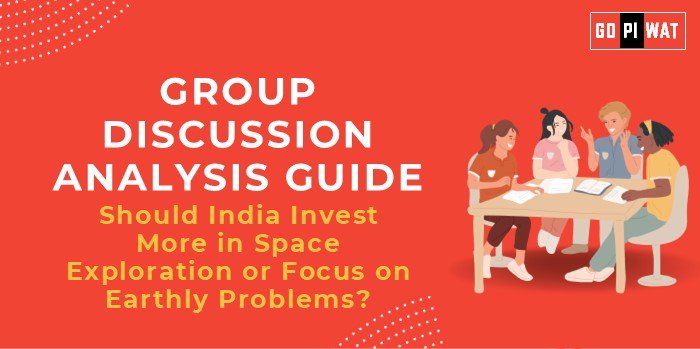📋 Group Discussion (GD) Analysis Guide
🌌 Topic: Should India Invest More in Space Exploration or Focus on Earthly Problems?
🌟 Introduction
India’s advancements in space exploration, exemplified by missions like Chandrayaan and the upcoming Gaganyaan, demonstrate its technological prowess. However, as the country contends with challenges like malnutrition and healthcare deficits, the debate over prioritizing space versus addressing immediate societal concerns gains relevance.
📊 Quick Facts & Key Statistics
- Space Budget: ₹13,042.75 crore (2024-25), a 4% increase from ₹12,543.91 crore in 2023-24.
- Poverty Statistics: 194.6 million undernourished Indians—the largest globally (2024).
- Healthcare Allocation: ₹90,000 crore (1.88% of total budget) in 2024-25, reduced from 2.16% in 2019-20.
- Environmental Impact: Space missions like Gaganyaan focus on minimizing environmental footprints.
- Global Standing: India is the third-largest renewable energy producer, with renewables comprising 46.3% of installed power capacity (October 2024).
👥 Stakeholders and Their Roles
- Government: Allocates budgets for both space exploration and socio-economic development.
- ISRO: Drives advancements in space technology with minimal costs.
- Private Sector: Innovates through startups like Skyroot, enhancing space-tech capabilities.
- Citizens: Balance expectations for cutting-edge advancements and improved living standards.
✅ Achievements and Challenges
🏆 Achievements:
- Cost-efficient missions like Chandrayaan-3 and Mangalyaan.
- Satellites aiding in agriculture, disaster management, and rural connectivity.
- Renewable energy leadership, with 46.3% of power capacity from renewables.
⚠️ Challenges:
- Persistent malnutrition affecting 194.6 million people.
- Healthcare budget shrinkage despite growing population needs.
- Socio-economic disparities limiting access to tech benefits.
🌍 Global Comparisons
- Success: NASA’s Artemis mission exemplifies space innovation driving economic returns.
- Challenge: Brazil’s environmental trade-offs for technological advancements.
📖 Case Study:
Kerala demonstrates a balanced focus on education, healthcare, and tech, achieving 93% digital literacy.
🔍 Effective Discussion Approaches
- Opening Approaches:
- Highlight ISRO’s cost-effective innovation compared to global benchmarks like NASA.
- Emphasize India’s socio-economic disparity, citing malnutrition statistics.
- Counter-Argument Handling:
- Advocate for space-tech solutions addressing earthly challenges, like weather prediction improving agriculture.
- Balance space ambition with welfare improvement through reallocated budgets.
📈 Strategic Analysis of Strengths & Weaknesses
- Strengths: Cost-efficient space program; renewable energy leadership; growing private sector participation.
- Weaknesses: Resource constraints; socio-economic challenges; environmental impact concerns.
- Opportunities: Expanding satellite usage for rural education and disaster management.
- Threats: Budget trade-offs reducing focus on healthcare and nutrition.
💡 Structured Arguments for Discussion
- Supporting Stance: “Space exploration is critical for India to assert technological leadership globally.”
- Opposing Stance: “With nearly 200 million undernourished citizens, welfare should take precedence.”
- Balanced Perspective: “A synergistic approach can harness space-tech benefits for societal upliftment.”
📚 Connecting with B-School Applications
- Real-World Applications: Case studies on budget optimization and project management.
- Sample Interview Questions:
- “Can space exploration directly impact India’s socio-economic challenges?”
- “How can India balance space ambition with human development?”
- Insights for Students: Analyze ROI of public investments and CSR potential in tech.


